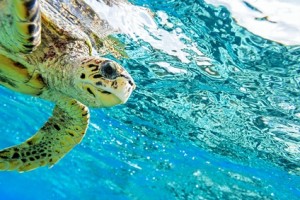

Yes – you read that right! But – no – we’re not talking Miley Cyrus, the human singer. We’re talking Miley Cyrus – the twerking loggerhead sea turtle.
Several months ago, a turtle in distress was rescued. It was noticed because its bobbing in and out of the water similar to the famous twerking move made famous by the singer. Unfortunately, this bobbing motion is not a good thing. It is an indication that the turtle was not able to dive underwater, which could eventually cause the death of this beautiful sea creature.
After being rescued, 120-pound Miley was treated at the Turtle Hospital in the Florida Keys and was finally rehabilitated enough to be released back into the Gulf to much fanfare and applause.
Sea turtles are fascinating creatures. They gain a lot of notoriety due to their nesting behaviors and anyone who lives anywhere near a Florida beach is familiar with the warning signs about hatchlings. Let’s look at some sea turtle facts:
* It’s a myth that hatchlings need a full moon in order to reach the ocean. Although they do instinctively move towards the brightest light that is often the horizon over the water. For this reason, anyone who lives near sea turtle nests are advised to keep outside lights off during hatching season.
* There are five species of sea turtles in Florida. All five are either endangered or threatened. These five species are: the Loggerhead, the Hawksbill, Kemp’s Ridley, the Leatherback and the Green Turtle.
* Kemp’s Ridley is the smallest of the five. They can grow to approximately 75 to 100 pounds.
* The Leatherback is the largest. It can grow up to 1,300 pounds and measure in at 8 feet!
* A female can lay approximately 100 eggs at a time. Only 1 in 1,000 eggs make it to the adult stage.
* It is estimated that sea turtles have remained relatively unchanged in the past 110 million years.
Some of the biggest dangers to the survival of the sea turtles include pollution, harvesting and habitat encroachment.
If you see sea turtles and they are in the process of nesting, hatching or the process of where the hatchlings travel back to the ocean, the best thing to do is nothing. Simply leave them be. Do not shine lights, make noises or try to help.
However, if you see a sea turtle in distress or a hatchling that is not moving to the water, contact the Florida Fish and Wildlife Conservation Commission at 1-888-404-FWCC.
